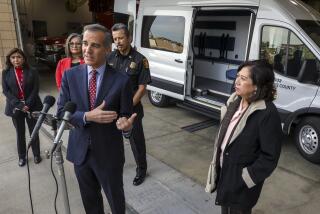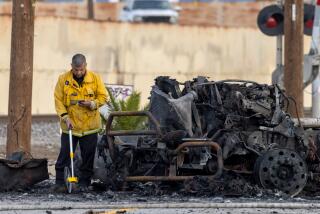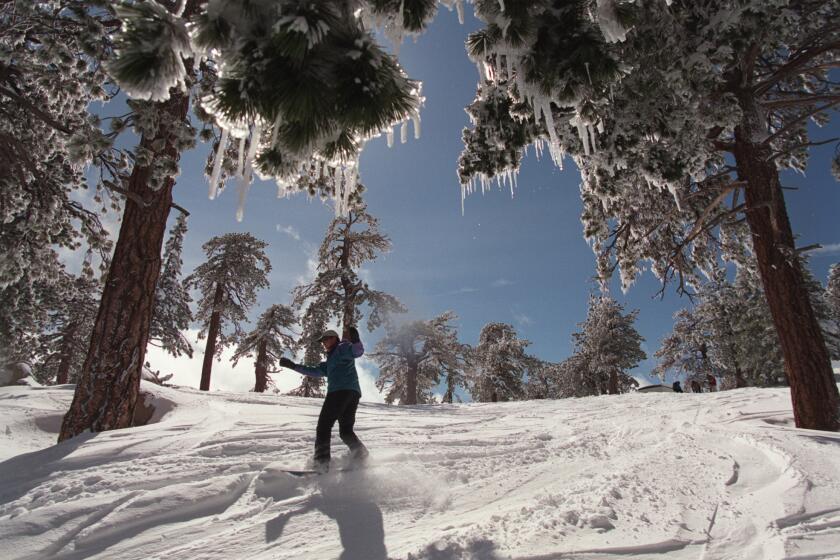L.A. Fire Department response times slow, data show
Waits for 911 medical help in Los Angeles increased slightly this year, signaling no measurable progress on Mayor Eric Garcetti’s campaign pledge to speed up Fire Department responses to emergencies, according to city statistics released Thursday.
Garcetti presented the new figures at a news conference in which he and Fire Chief Ralph Terrazas praised LAFD efforts to overhaul how the agency gauges its performance.
The new numbers come from a program dubbed FireStat-LA, which is being billed as the cornerstone of a 2-year-old reform drive. The effort began after LAFD officials admitted issuing faulty reports that made it appear the department was performing better than it was.
The ensuing controversy sparked investigations, pledges to improve 911 service from candidates in last year’s mayoral contest and the early retirement of former Fire Chief Brian Cummings after Garcetti took office.
Garcetti said the new information-gathering system is the foundation of changes to come. “Now we can look people in the eye and say this is real,” he told reporters.
He said the FireStat program will help increase accountability, improve decision-making and lead to better allocation of personnel and equipment. As a result, Garcetti said he expects to begin trimming tens of seconds off response times in the coming year.
The new statistics, available on a station-by-station basis on the Fire Department’s website, followed months of work by outside experts and a newly hired civilian statistician at LAFD.
Citywide, it takes a little more than six minutes and 30 seconds on average for the first rescue unit to arrive at a medical emergency after a 911 call is answered at the LAFD’s downtown dispatch center, according to the new statistics. That number ticked upward by three seconds in 2014, the new data show.
Average 911 wait times are significantly longer in some parts of the city, particularly in the winding roads of the Santa Monica Mountains and in the narrow strip of the city that stretches from South Los Angeles down to San Pedro. At Fire Station 109, perched on Mulholland Drive south of Encino, times are about three minutes longer than the citywide average. .
The findings match the conclusions of independent studies conducted by The Times in 2012.
“It depends where you are,” said veteran firefighter Steve Tufts. “When we’re not there in three minutes, there’s a reason for it. It’s no fault of the firemen. It’s the distance from the station. Or they are out on another call.”
Garcetti partially echoed that view Thursday. “We will never have the same response time throughout the entire city,” he said. “But we can reduce response times everywhere.”
Officials said they are sharing the new response-time analysis with rank-and-file firefighters at fire station meetings, with an eye toward identifying ways to improve performance.
What remains unclear is whether the new statistical analyses will lead to a broader restructuring of how the LAFD deploys units and responds to hundreds of thousands of calls for help each year.
This year, an outside consultant hired by the city criticized the LAFD for not pursuing more fundamental reforms, including replacing firefighters with lower-paid civilians in jobs such as answering calls and pre-positioning units outside of fire stations based on service demands.
Union leaders, who wield significant influence at City Hall, have opposed many of those recommendations, arguing that hiring more firefighters should be the city’s top priority.
Garcetti has proposed a consolidation of the city’s police and fire 911 call centers. While he didn’t unveil any other specifics Thursday, Garcetti said more changes could be coming.
“Everything is on the table,” he said.
More to Read
Start your day right
Sign up for Essential California for news, features and recommendations from the L.A. Times and beyond in your inbox six days a week.
You may occasionally receive promotional content from the Los Angeles Times.







